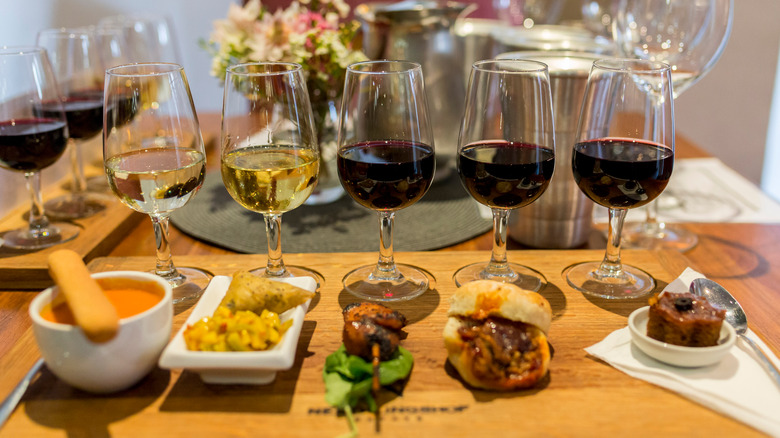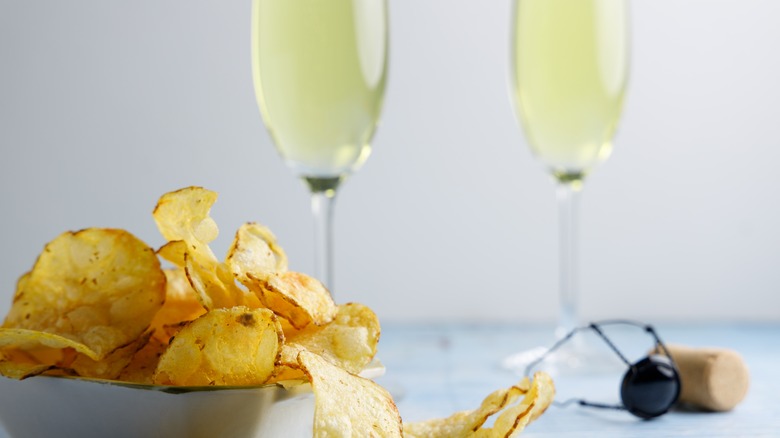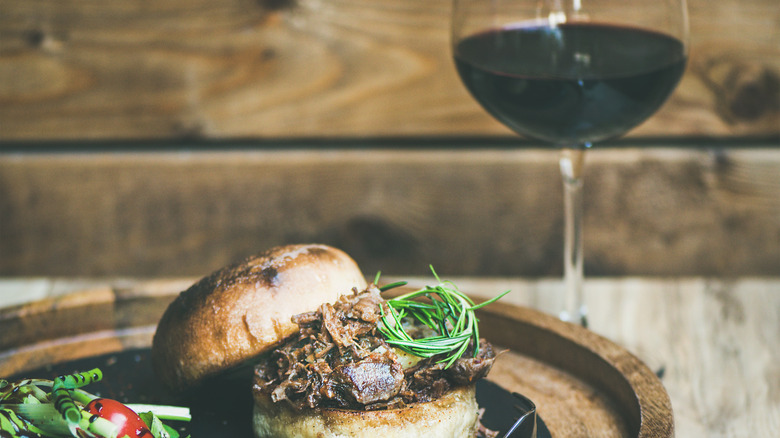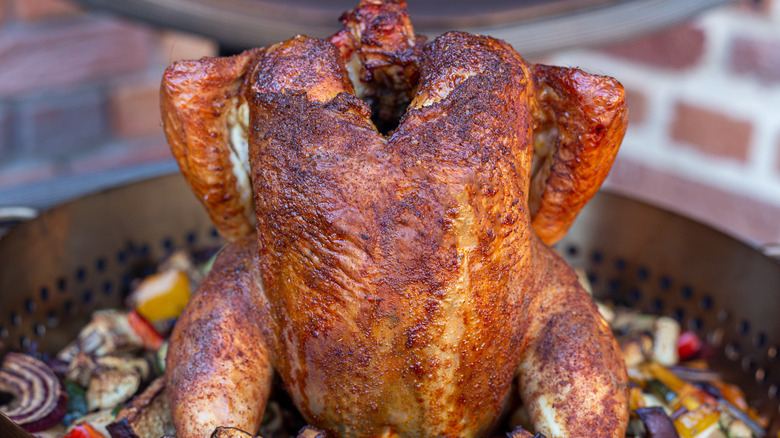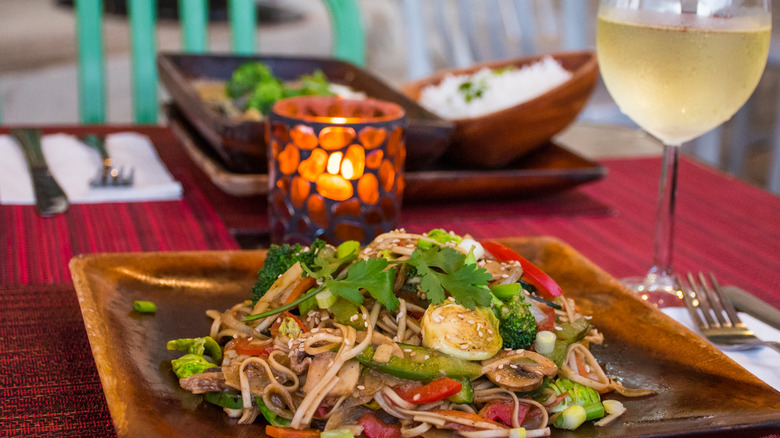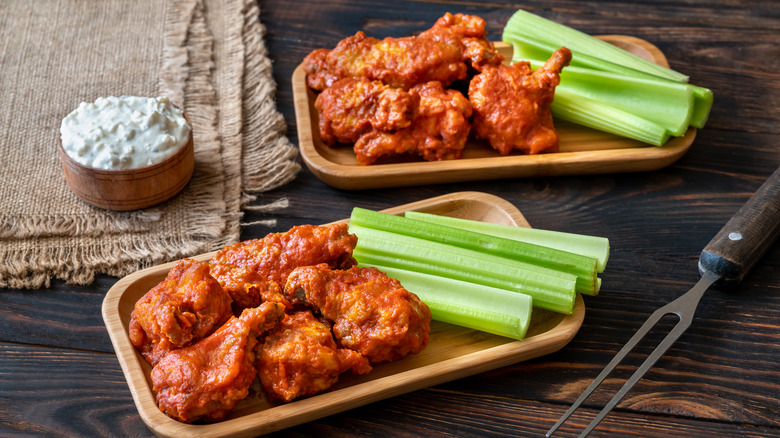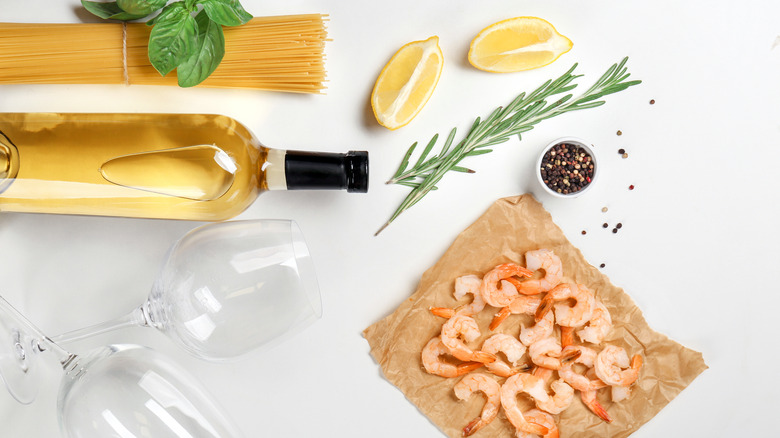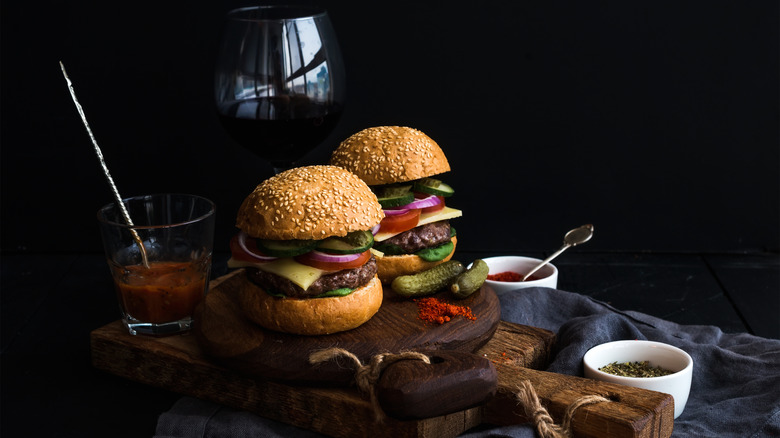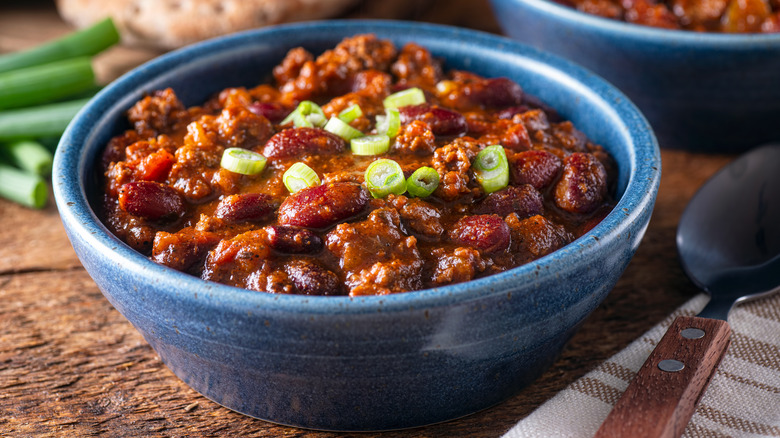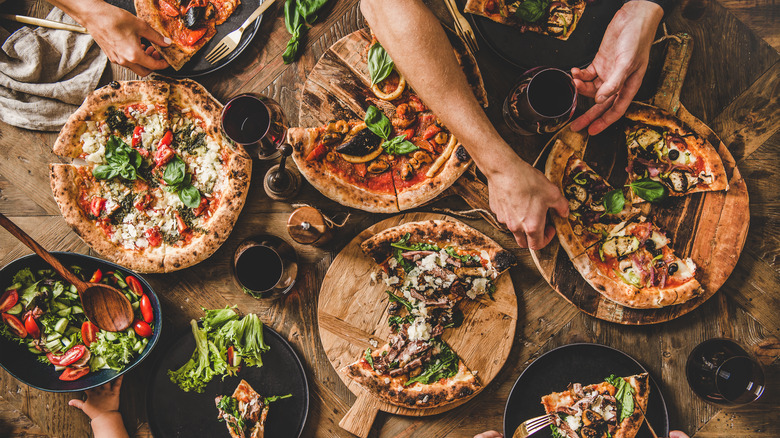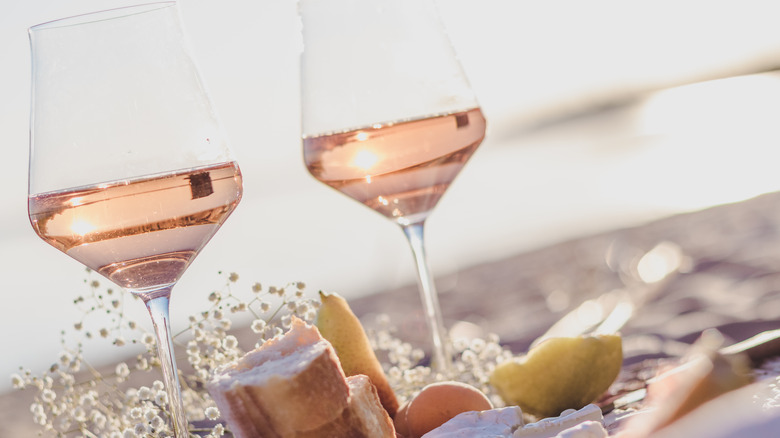10 High-End Wines To Pair With Everyday Food
Have a special bottle gathering dust in your cellar? No need to plan an elaborate meal around it — in fact, the same pairing rules apply to snacks, comfort foods, and takeout. Wines with more residual sugar are great for cutting through rich, fatty foods; high acid wines will temper spice; deep, concentrated tannic expressions need a hefty counterpart; and lighter, fresher styles can amplify delicate dishes.
The fact of the matter is that the best pairing is the pairing you enjoy — there is no shame in enjoying beef jerky with some Champagne, just as it's perfectly fine to have a fancy meal of coq au vin with a glass of $12 malbec.
We flipped the script on luxury wine pairings for people that don't want to spend 12 hours a day hovering over an oven or have a standing reservation at Le Bernadin. These are just simple meals that will shine when paired with your special bottle. We could say, "try the Champagne paired with thinly-sliced fingerling ovals crisped in a delicate washing of olive oil and sea salt," but we think it might be more fun to pop open that same bottle of Champagne and shamelessly enjoy it with a bag of potato chips.
Champagne and potato chips
Who knew you could find the perfect accompaniment to Champagne at a gas station? There's no need to splurge on caviar when potato chips offer the same ideal pairing to your bubbly. Food & Wine said it best: "Salt and fat both love Champagne (and vice versa) — the wine's high acidity and the prickle of those bubbles are the ideal preparation for the next chip, and the next, and the next, and so on."
Caviar is considered a perfect match to Champagne because the zesty acidity inherent in Champagne (and other dry bubblers) cuts through the salinity of the caviar, while the caviar mitigates the wine's acidity, making it a very culinary circle-of-life situation. The same thought process lies behind the genius of a potato chip and Champagne pairing. The dry and effervescent bubbly cuts through the salt and fat like a palate cleanser, and in turn, the fat from the potato chips tempers the acidity of the Champagne.
Barolo and pulled pork sammies
Made from the Nebbiolo grape, Barolo is a profoundly complex wine lauded for its zippy acidity and tannic structure. It has the ability to come across as light and fresh while also being full-bodied and brooding (per VinePair). The signature aromas in Barolo are tar and roses — the dissonant characteristics driving home how mysterious it is. For this reason, it is known as "the king of wines" — but you don't need a royal feast to enjoy it.
When pairing Barolo and food, consider the high levels of acid, tannin, alcohol, and aromas. The complexity of the wine requires a dish that can hold its own next to it. The best food pairings are dishes with high-fat content, an acid component, and protein. A meal that checks all those boxes is a classic pulled pork sandwich. Usually made with slow-roasted pork shoulder, the fat breaks down and mixes with the juices. The acid component comes from the apple cider vinegar used during the cooking process and the vinegar and tomato-based sauce that gets mixed in post-roast. While it is a simple meal, it is multi-layered and checks all the boxes for a perfect pairing.
Grand cru Burgundy and beer can chicken
Grand Cru Burgundy is one of the most expensive and allocated wines in the world. All red Burgundy wines are made with pinot noir. The Grand Cru designation is a classification, according to Beaune Tourism, assigned to the highest echelon of Burgundy wines produced using the best plots. Romanée-Conti is the most famous of Burgundy's grand cru appellations, which is why Domaine Romanée-Conti (DRC) wines fetch such handsome prices. The average production is just 5,980 bottles per year.
These wines are effortlessly balanced and pristine. Typical attributes are soft notes of cherry and earthy bramble that lead to a chalky minerality. In addition, they have racy acidity and a silky texture. With an average price point of $26,000, it might sound crazy to drink it with *checks notes* beer can chicken, but hear us out.
Cooking chicken this way results in a juicy inside and crackly, crispy skin outside. The beer works to keep the inside hydrated while it cooks. The delicate texture it creates mirrors the finesse of your prized bottle of DRC. The chicken skin's spices echo the earthy notes in the wine, and the lushness keeps the acidity of the wine in check. So go ahead and stick a beer can up a chicken's rear and open up that bottle worth what some people make in a year!
GG Riesling and pad Thai
Regarding classification, there is no doubt that Germany has the most orderly and effective system. The Prädikat System categorizes Rieslings into groups ranked by must weight (sugar content) but leaves no space for the gorgeously concentrated, bone-dry Riesling. To showcase these wines, the GG designation was made in the early 2000s. GG is short for "grosses gewächs," meaning "great growths," according to Morrell Wine. In order to make the cut, many specific rules must be adhered to — yields must not exceed 50 hectolitres per hectare, and the grapes must be hand-harvested when fully ripe and of exceptional quality. These wines are in a class of their own. They boast spine-tingling acidity, a concentrated mouthfeel that feels unctuous even though it is dry. Flavors are citric, honeyed, and floral with a mineral undertone.
A lovely counterpart to a GG Riesling is pad Thai. The electric acidity makes the dish's ingredients stand out while moderating the rich sauce. The lime zest note in the Riesling mimics the squeeze of lime on the noodles. For spicier pad Thai dishes, the fresh peach and honey notes of the wine ease the burn of the heat and balances the entire meal.
Royal Tokaji Essencia and buffalo wings
Royal Tokaji Essencia is the most expensive wine in the world and is typically sold in 375 ml bottles. According to Trafalgar, this Hungarian dessert wine retails at a mind-boggling $40,000. Why is such a small bottle of wine so expensive? The process of making Royal Tokaji Essencia is intense. After only picking noble rot grapes one by one, the honeyed essence of the grapes is extracted — it takes a kilogram of these prized grapes to produce just five milliliters. Then, the fermentation process is incredibly long — six to eight years — so cellar space and vessels are necessary. The outcome is worth it, however. Essencia is cloyingly sweet — most people only want about a spoonful (which is good because each spoon costs $140!). Still, the acidity is incredibly high, making it a perfectly balanced bottle. This profoundly complex wine is honeyed on the nose with aromas of freesia, honeysuckle, and orange peel.
So why are we pairing it with something you can buy for 25 cents each? Because buffalo wings and Essencia complement each other gorgeously. The sweetness of the wine regulates the heat of the wings, the crispy skin of the wings counterbalances the wine's lush, silky mouthfeel, and the wine's high acidity cuts through the rich blue cheese. It will undoubtedly be a game day to remember!
Chablis and shrimp scampi
Another Burgundian wine has made our list and for a good reason — Chablis is chardonnay made in the Chablis region of France (in Burgundy), but it is very different from chardonnay made anywhere else. The high-price tag is partly due to the method of production, as these wines are rarely oaked. And when they are, it is typically in neutral oak. Another reason is the climate — the cool climate of Chablis allows the grape to ripen slowly, making a delicate style of wine. But the most important reason is the soil — the limestone and ancient fossils on which the vines are planted give the wine a matchless minerality (per Chablis Wines).
These wines beg to be paired with seafood, so we chose to partner it up with some shrimp scampi. The Chablis complements the richness of the pasta and its citrusy notes play well with the lemon in the dish. The shrimp's brine also matches the wine's salinity and mineral-driven backbone.
Screaming Eagle and cheeseburgers
The iconic Screaming Eagle cabernet from the Napa Valley is one of the most allocated wines. Rather than finding an online shop on their website, there is a waiting list. And this big and bold style is made for aging — grippy tannins and a full body give it heft while the flavors and aromas sing of fresh cassis, black plums, coffee beans, and dried herbs. As it ages, the notes will evolve into tertiary characters of balsamic, wet walnuts, and resin. At the 2000 Napa Valley Wine Auction, a 6-liter Imperial bottle of 1992 Screaming Eagle cabernet sauvignon sold for $500,000. So, are we crazy for enjoying it with a cheeseburger?
Nope. The wine's heft stands up to the burger's heartiness, and its acidity complements toppings like red onion, ketchup, and lettuce while mitigating the fattiness of the meat. Meanwhile, the protein and fat lipids in the burger work to smooth over the intense tannins in the juice. So please share your highly allocated Screaming Eagle at a barbecue with friends. After all, wine is about conviviality, not exclusion.
Madeira and brownie sundae
Madeira is a fortified wine that has been enticing the world for 300 years. Made on the island of Madeira in Portugal, this wine came to fruition thanks to the sea trade. According to Wine Folly, to survive a voyage at sea, winemakers began fortifying their wines (adding distilled spirit) to keep them from spoiling. As the ships made their way through the tropics, the casks of wine were heated by the hot sun and then cooled by the chilly nights in the open air. Producers noticed the unique characteristics that came through as a result of the heating and cooling process and began to replicate it on land. The outcome was a sticky-sweet wine with hazelnut notes, burnt sugar, orange peel, and stone fruit.
Not only is a brownie sundae a perfect pairing, but you can also opt to pour a little Madeira onto your sundae as a sweet syrup. The Madeira and the brownie sundae are equally rich and compatible with each bite and sip. In addition, Madeira has quite a bit of acidity that can assuage the cloyingness of the sundae. The nutty notes from the Madeira also mesh well with any walnuts you choose to top your sundae with.
Bordeaux red and chili
A Bordeaux red blend is a deep and complex mix of cabernet sauvignon, merlot, and cabernet franc (and possibly some petit verdot, malbec, and/or carménère) made in the Bordeaux region of France. Wine Folly tells us that these wines exude rich flavors and aromas of black currant, plum, graphite, cedar, and violet. This wine's full body and parching tannins call for a meal worthy of its intricacy and weight. While many red Bordeaux options won't hurt your pocket, the best expressions can be pretty pricey, with some costing upwards of $12,000 per bottle.
To ensure a smooth pairing, fat is needed to smooth rough tannins in the wine. But you'll also want something acidic and savory to match the wine's acidity and maximize its earthy undertones, respectively. Chili checks all those boxes — a glass of Bordeaux with a steaming bowl of beef chili on a cold winter night is an ideal pairing. The beef in the chili offers plenty of fat and umami to quell those rugged tannins, the tomato paste matches the wine's acidity, and the herbs and spices used in the dish bring out rustic notes in the wine.
Penfolds Grange and pizza
Wine critics and connoisseurs await the release of Penfolds Grange each year and each bottle has an average price point of around $700. However, exceptional vintages have been known to auction for much more — the 1951 vintage sold for $67,000 AUD ($78,000 USD). Made with Shiraz, this wine — produced by one of Australia's most iconic wineries — is one of only a few bottles that boasts 100-point scores from some of the world's leading wine critics. On the palate, you'll find concentrated black and red fruits, a backbone of firm tannins, layers of spice, and a velvety texture.
Sure, many call bargain bin reds "pizza wines," but we are taking the pairing to a whole new level by partnering a pie with a bottle of Grange. The wine's ripe fruitiness tempers the tomato sauce's sugar and acid combination, and its boldness stands up to the cheese's richness while complementing its creaminess with a velvety mouthfeel. Shiraz can enhance the flavors of anise or fennel in sausage with its own tones of licorice, so a pizza topped with meat might be the way to go
High-end ageable rosé and street tacos
With the surge in popularity of rosé, many producers have tapped into the luxury market by releasing oak-aged and ageable rosés. For example, Gérard Bertrand released Clos du Temple, which retails for over $200! Marketing these as food-driven wines means they should be sophisticated and complex enough to serve alongside meals heftier than salads. This style of rosé goes beyond the light and crisp, fruit-forward easy drinkers and adds layers of spice and texture imparted from the oak. The acidity is still there in mouthfeel and weight, but the body is plumped up. While flavors of fresh strawberry, peach, and citrus still shine, there is an undercurrent of spice and possibly vanilla.
We chose street tacos as a perfect pairing because they are as versatile as these wines. Cilantro plays well with the savory notes in the rosé while raw onion holds its own against the wine's acidity. The fresh fruit notes temper the heat from the hot sauce, and the edge of the wine is softened by the protein and fat of whichever meat you choose. Street tacos aren't super light but they're also not incredibly rich, making them a beautiful medium-bodied food to match with a heftier rosé.
